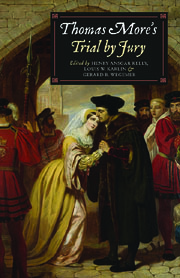Book contents
- Frontmatter
- Contents
- List of Contributors
- Preface
- Abbreviations
- Chronology
- 1 A Procedural Review of Thomas More's Trial
- 2 Natural Law and the Trial of Thomas More
- 3 A Guide to Thomas More's Trial for Modern Lawyers
- 4 Thomas More's Three Prison Letters Reporting on His Interrogations
- 5 Judicial Commentary on Thomas More's Trial
- Appendix 1 Documents
- Appendix 2 Thomas More's Trial: Docudrama
- Bibliography
- Index
4 - Thomas More's Three Prison Letters Reporting on His Interrogations
Published online by Cambridge University Press: 05 February 2013
- Frontmatter
- Contents
- List of Contributors
- Preface
- Abbreviations
- Chronology
- 1 A Procedural Review of Thomas More's Trial
- 2 Natural Law and the Trial of Thomas More
- 3 A Guide to Thomas More's Trial for Modern Lawyers
- 4 Thomas More's Three Prison Letters Reporting on His Interrogations
- 5 Judicial Commentary on Thomas More's Trial
- Appendix 1 Documents
- Appendix 2 Thomas More's Trial: Docudrama
- Bibliography
- Index
Summary
Overview
Among the thirteen extant letters that More wrote between mid-April 1534 and July 5, 1535 are three important letters about an interrogation at Lambeth in 1534 and two later interrogations at the Tower of London in the spring of 1535 that he sent to his daughter, Margaret Roper:
Letter of c. April 17, 1534 (no. 200 [6]).
Letter of May 2 or 3, 1535 (no. 214 [20]) (Doc. 4).
Letter of June 3, 1535 (no. 216 [22]) (Doc. 6).
They are, in some sense, personal letters, and it was important for both More's sake and his daughter's that they be perceived so. On June 14, 1535, 11 days after he wrote the third letter, More was asked about letters he had written “touching” “the Acts of Succession, of Supreme Head, or the act wherein speaking certain words of the king is made treason.” After discussing his letters to and from John Fisher, More added that he had sent letters to Margaret Roper by way of George Gold, “both after his first examination and after his last” (presumably April 30 and June 3, 1535) out of worry that his daughter, “being (as he thought) with child … might take harm” when she heard that the Council had interrogated him. He had told “her the answers he had given” and stressed his obedience. He also pointed out that “she had written to him before divers letters, to exhort him and advertise him to accommodate himself to the King's pleasure.” This did not allay the Council's suspicions, then or later.
- Type
- Chapter
- Information
- Thomas More's Trial by JuryA Procedural and Legal Review with a Collection of Documents, pp. 94 - 110Publisher: Boydell & BrewerPrint publication year: 2011

